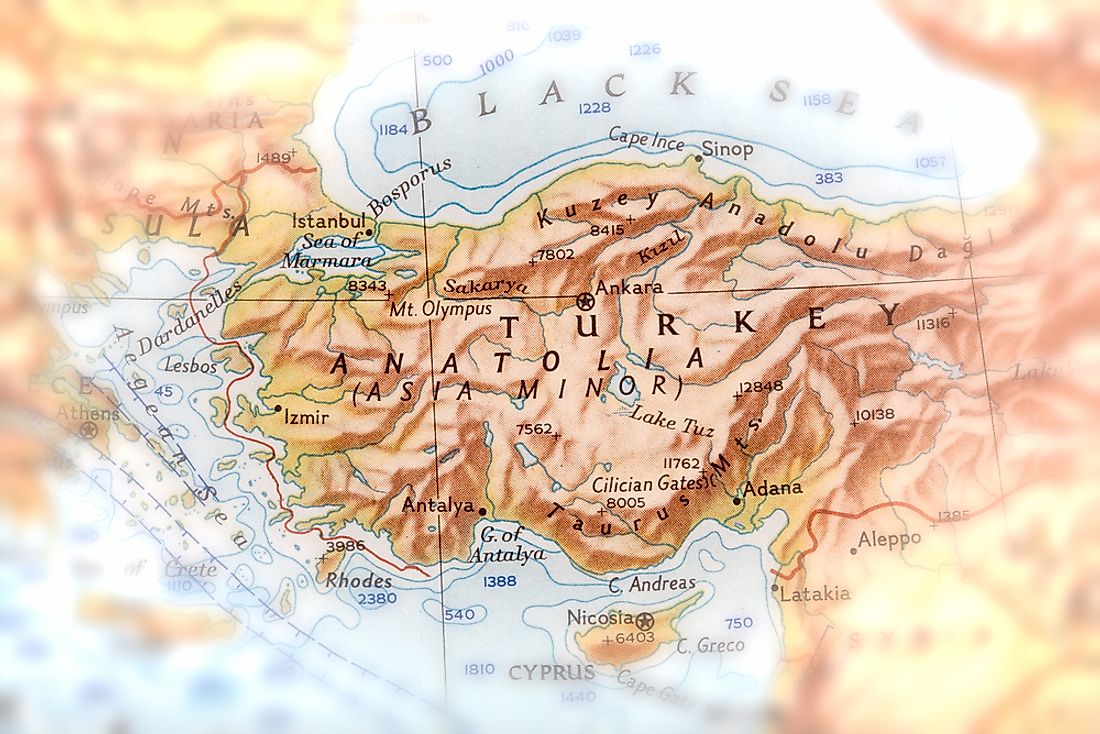Where is Asia Minor?

Asia Minor also referred to as Anatolia or the Anatolian plateau is the westernmost protrusion of the Asia which comprises mainly of modern day Turkey. Asia Minor is usually synonymous with Asian Turkey, which is made up of almost the entire country. The southeastern and eastern border of Asia Minor is the current border of Turkey with neighboring Armenia, Iran, Iraq, Georgia, Azerbaijan, and Syria. About 95% of Turkey’s land is in Asia Minor. The ancient inhabitants of Asia Minor spoke the Anatolian language which is now extinct and were replaced by the Greek language starting from the classical antiquity and during the Hellenistic, Roman, and the Byzantine periods. Asia Minor has an area of about 291,773 square miles, an average length, and breadth of about 650 and 300 miles respectively. Asia Minor is bordered by the Black Sea, Mediterranean Sea, the Aegean Sea, the Sea of Marmara and the Armenian highlands to the north, south, west, northwest and east respectively. Asia Minor is separated from Europe by the Straits of Dardanelles and Bosphorus.
History Of Asia Minor
Asia Minor is considered as one of the important regions where the evolution of human who settled in the region during the Palaeolithic and Neolithic periods. Ancient kingdoms that ruled in Anatolia include Akkadian Empire, Assyrian Empire, the Hittite kingdom, and neo-Hittite and neo-Assyrian kingdoms. The Greek kingdom under Alexander the Great and the Roman Empire occupied Asia Minor during the classical period. The Ottoman Empire emerged as a powerful dynasty in the 15th century resulting in the spread of Islam in the region. The area of Asia Minor was established as Turkey in 1923 after the decline and fall of the Ottoman Empire following the Turkish war of independence between 1919 and 1923.
Geography And Climate Of Asia Minor
Asia Minor is an uplifted almost rectangular area of land. The region is geographically diverse with mountainous regions, coastal plains, rivers, and lakes. Anatolia (most of modern Turkey) is divided into six distinct regions including the Aegean, Black Sea, Mediterranean, Central Anatolia, Eastern Anatolia, and South-eastern Anatolia regions. The Marmara region is towards the European part of Turkey. The Aegean region has fertile soils and a Mediterranean climate as well as the longest coastline. The Black Sea region is the most forested area with a steep coast and narrow valleys due to the increased mountain ridges. Central Anatolia region is the more semi-arid area of the Anatolian plateau with high rates of soil erosion due to overgrazing. Like its geography, Anatolia has a widely varied climate including continental, Mediterranean, and temperate oceanic climate. The region, therefore, experiences variations in temperatures during various seasons as well as the amount of precipitation received. For instance, the central region experiences a continental climate with hot summers and cold winters with snow and receives low and irregular precipitation.
Biodiversity Of Asia Minor
Asia Minor is home to a diverse range of ecological zones including temperate, broadleaf, coniferous, mixed and Mediterranean forests, woodlands, scrublands, steppes, and montane forests. Within these Ecoregions existing there are diverse collection of endemic flora and fauna. Plant species within the Anatolian plateau include the Turkish pine, strawberry tree, Kermes oak, Bay Laurel, the Anatolian Black pine, the cedar of Lebanon, the Aleppo pine, and the dry oak. Animal species include about 1500 vertebrate species and more than 19,000 invertebrate species with high rates of endemism. Asia Minor is an important route for migratory birds, especially in spring and autumn. Some of the animals in the region include the Mediterranean monk seal, the northern bald ibis, the white-headed duck, the red-breasted goose, the great bustard and the eastern imperial eagle.











